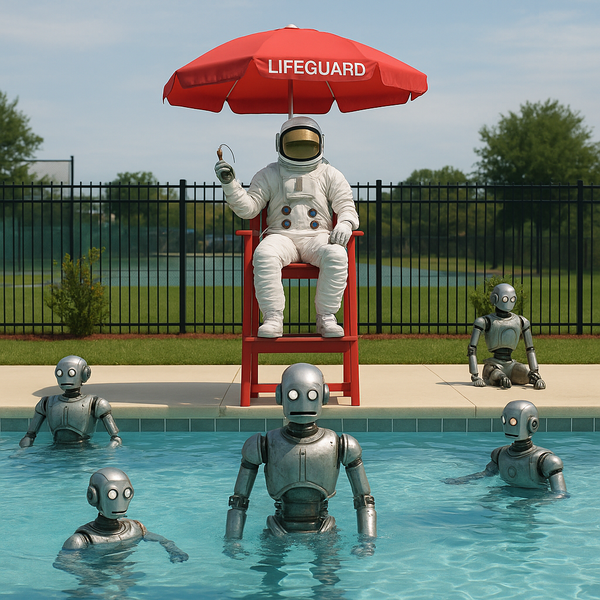Building brands in a creator era
Easy on paper, hard in reality

The end of mass media, which has fragmented into millions of niches, presents a dilemma for brands. They know they cannot rely on the typical channels to reach new audiences, only the current value placed on authenticity makes creator partnerships fraught with potential pitfalls that big brands want to skip. TRB regular and veteran content marketer. Lucas Quagliata offered to contribute his perspective on the topic. Get in touch if you want to contribute to a future issue: bmorrissey@therebooting.com.
It comes as no shock that the current digital climate is a tough place to build brands. While that’s a convenient excuse to skip over trying to do so, marketers who do not build their brand choose that path at their own peril.
But what should brand advertising mean when the mass media that’s served as the focal point of brand advertising is in decline? Simultaneously, there is an increased value being placed on authenticity. Marketers seek efficiency and authenticity, which is how you end up with Ben Affleck in a Dunkin’ commercial. That’s pretty singular, though. It’s a tough approach to replicate.
Companies need to grow into new audiences. An existing customer base isn't enough, you've got to convince some new cohort that you're worth their time and money. In the world I work in, legacy banks and portfolio managers are struggling to convince a generation raised on Venmo and Robinhood that they should take the time to talk to an advisor, let alone walk into a physical branch to open an account.
Communicating with this younger cohort is going to stretch your authenticity. Brands often show up with a baseball hat on backwards: “How do you do, fellow kids?” Yet there’s no choice when those potential new customers aren't interested in ads, or even spending most of their time in mass media channels with established mechanisms for communicating brand messages.
The answer to this has been partnerships. Finding influencers creators and organizations that have a foothold with one group or another and doing a deal that allows for a deeper integration and multiple touchpoints. This way you show up to a new audience not with just a #PaidPartnership, but a budding new relationship that can grow over time. You step out of traditional advertising with a guide who can help translate for you to a new and desirable audience.
In a previous role with an Internet Service Provider, my team worked with a roster of eSports creators who were eager to form a partnership and earn some real brand money. The brand I worked with was intent on pushing into the demo to prove out their top speeds, but gamers are famously cynical about drive-by advertising. A long-term partnership was the way in, and both sides were happy to do the deal.
Creators seeking funds and mainstream reach combine with a brand that needs an injection of creativity and access to an audience they won't be able to reach - or at least that they won't be able to resonate with - without some kind of alternative approach. These deals always seem simple and logical on their face.
No matter how well the contracts are negotiated, you're going to run into difficulties.The beginnings of these deals are often very smooth and full of platitudes about reach and freshness and creativity. When the rubber hits the road, though, the situation can prove more difficult. The creators are protective of their work and their audience. They're not interested in serving up overly branded ads. The brands, meanwhile, aren't interested in signing off on what could be perceived as a forgettable mention or ill-placed logo that's overwhelmed by the sea of content being produced. What’s the staying power in an Instagram Story?
There is a path forward, a way to ensure that these kinds of content deals actually work out for both parties. Here are a few principles that will help you on your way to success.
Content Literacy: Someone from the brand needs to know what kind of content the creator is producing. You need to speak the language with some amount of fluency. These deals are not going to work if you don't understand the memes, references, and style of the creator. I'm always surprised at how little brands are willing to engage with the work of the people they are willing to hire. Did Penn Entertainment have any idea what Barstool did before they purchased it? That was a full acquisition, sure, but the point stands.
Follow the social accounts, listen to the podcast, and watch the YouTube channel. Contrary to popular belief, the comments section can bring some significant enlightenment in these situations. Not all the comments, but some of them will definitely show the mood of the audience and include further references it would be wise to understand. And if there aren't any comments, that's a red flag, too.
On the creator side, you should know where the limits are for the brand you're working with. That doesn't mean you can't try to push them, but there should be an understanding of what they've done before and where they will be comfortable. Also, the brand is looking for some kind of co-sign from you. They want to collaborate. Really consider how to mesh your home grown creativity with the brand's more traditional approach.
Flexibility: . Both parties are responsible for being flexible with what they're asking for and what they're creating. Understanding there are some non-negotiables, both the brand and the creators need to be willing to listen and give a little. Both parties may very well veer into a place where they're not totally comfortable, and that's ok! That's part of why you do collaborations like this.
The main takeaway here is to not be too precious about any one thing. Legal obligations notwithstanding, try not to get sued into oblivion, it's OK to push boundaries and try something new. If it doesn't work, you don't have to do it again. But limiting yourself at the start is defeating the purpose of doing work like this in the first place. The point —for the brand and the creator — is to stretch a bit. A legacy financial brand should hesitate to use slang. A very hip creator should hesitate to cosign some stodgy bank. They both need to flex a little to make their partnership work.
Backchannel Communication: There has to be an effort on both sides to really talk things through and gain mutual understanding. That’s not happening in a bunch of big meetings with 10 people, half of which don't know anything about the campaign that's running or the people who are making it.
Hopping on one-on-one calls, creating side threads, texting people, soothsaying the lawyers when they get nervous to ask them what word we can use, all of these need to be happening in the background. If any partnership like this is going to be successful then it needs to be a true partnership, one where folks are willing to take the extra time and go out on a limb for each other. This is where the flexibility negotiations can really take place, where someone from the brand and someone from the creator’s side can agree to try something one way first and then another way later on. This is where trusting relationships can be built and success can be achieved.
Honesty: The last piece of advice here is just to be honest about the work. This should apply to creative feedback, of course, but the real need for honesty is more existential than that. It doesn't help anyone to endlessly tweak creative if the core partnership just isn't going to work. You're not going to strike gold all the time and there are going to be some swings and misses. That's fine, it will inform your path going forward. There is no need to spin your wheels for no return, and not everything that seems like a match at the beginning of the relationship will end harmoniously. Even if it doesn’t, try to be gracious and don’t burn bridges on the way out.
There's never any guarantee when it comes to marketing. I regret to inform you that until the end of time, half of your spend is going to be wasted. That's the name of the game. But by following some of these principles and putting the right foot forward with some intentionality, maybe it won't be your half. Or, at the very least, you'll have some fun. Maybe at the end of the day, the real marketing ROI was the friends we made along the way.
Just don't tell the CFOs.
Lucas is a marketer who has spent time in the field in various industries for the last decade plus. He writes the State of Play newsletter.



